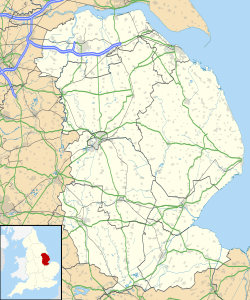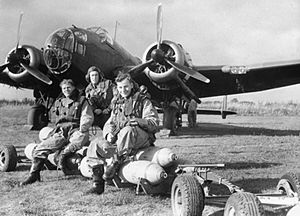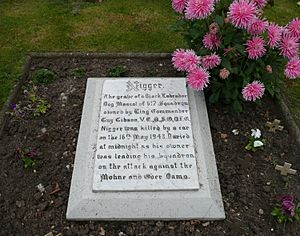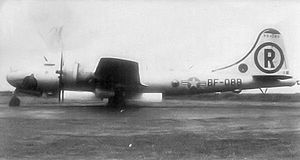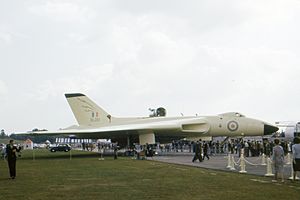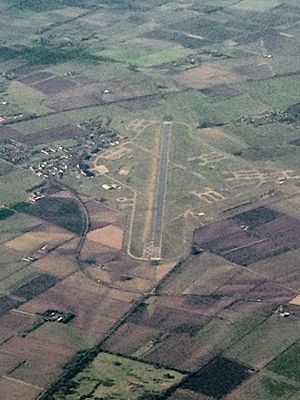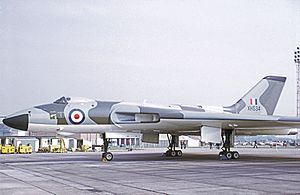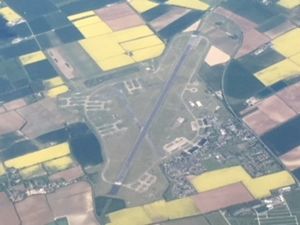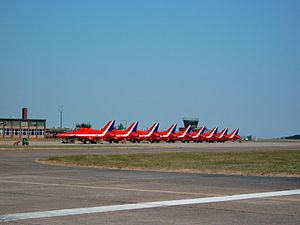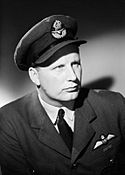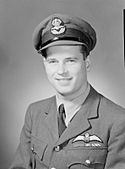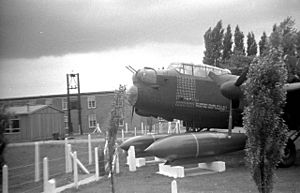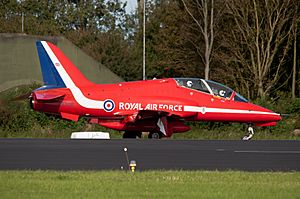RAF Scampton facts for kids
Quick facts for kids RAF ScamptonFormerly RFCS Brattleby |
|||||||
|---|---|---|---|---|---|---|---|
| Near Scampton, Lincolnshire in England | |||||||
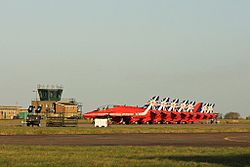
The Red Arrows at their old home, RAF Scampton
|
|||||||
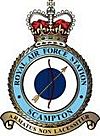
|
|||||||
|
Shown within Lincolnshire
|
|||||||
| Coordinates | 53°18′28″N 000°33′03″W / 53.30778°N 0.55083°W | ||||||
| Type | Royal Air Force station | ||||||
| Site information | |||||||
| Owner | Ministry of Defence | ||||||
| Operator | Royal Air Force | ||||||
| Condition | Closed | ||||||
| Site history | |||||||
| Built | 1916 and 1936 | ||||||
| In use |
|
||||||
| Airfield information | |||||||
| Identifiers | IATA: SQZ, ICAO: EGXP, WMO: 03373 | ||||||
| Elevation | 62 metres (203 ft) AMSL | ||||||
|
|||||||
Royal Air Force Scampton, or RAF Scampton, was a special base for the Royal Air Force (RAF). It was located near the village of Scampton in Lincolnshire, England. The base was about 6 miles (10 km) north-west of the city of Lincoln.
RAF Scampton started as a landing field during the First World War. It was called Brattleby back then. After the First World War, the base closed and the land was used for farming again. It reopened in the 1930s. Over the years, it was home to fighter planes in the First World War, bombers in the Second World War, and V-bombers during the Cold War.
The base closed for a short time in 1996. But it reopened to become the home of the RAF's amazing aerobatic team, the Red Arrows. Private companies also used it for aircraft care. In July 2018, the Ministry of Defence announced that RAF Scampton would close for good. All its units would move to other places. The base officially closed on March 31, 2023.
Contents
- History of RAF Scampton
- What RAF Scampton Did
- Heroes of RAF Scampton: Victoria Cross Recipients
- Former Leaders of RAF Scampton
- Scampton Airshow: A Look Back
- Heritage and History at Scampton
- Images for kids
History of RAF Scampton
Early Days: First World War
The airfield first opened in late 1916. It was called Home Defence Flight Station Brattleby. It was used by the Royal Flying Corps. The first planes there were Royal Aircraft Factory F.E.2b aircraft. They helped protect against Zeppelin airships.
Later, it became a training base. Pilots learned to fly planes like the Sopwith Camel and Sopwith Pup. In 1917, the station was renamed Scampton. It closed in April 1919. All the buildings were temporary, so the land went back to being farmland.
Between the World Wars
In 1936, the RAF started to grow quickly. Many new bases were built, and Scampton was one of them. It was designed as a modern bomber station. When it reopened in August 1936, it was called Royal Air Force Station Scampton.
The new base had four large hangars and permanent brick buildings. These included offices, living quarters for officers and airmen, and homes for families. The base grew to cover about 360 acres (146 hectares). It became a noticeable feature on the Lincolnshire Edge, a famous limestone ridge.
The first squadrons at Scampton were No. 9 Squadron and No. 214 Squadron. They flew planes like the Handley Page Heyford. Later, No. 49 Squadron and No. 83 Squadron arrived. They flew the Hawker Hind and then the Handley Page Hampden.
Second World War: A Busy Time
1939–1942: The Start of War
When the Second World War began, RAF Scampton became part of Bomber Command. On September 3, 1939, just hours after war was declared, planes from Scampton launched the RAF's first attack. Nine Hampden bombers, including some led by Flying Officer Guy Gibson, flew to Germany. Scampton's squadrons also performed dangerous low-level minelaying missions, called 'Gardening'.
For a short time, the base was home to the Avro Manchester bomber. Then, the squadrons switched to the famous Avro Lancaster bomber. By June 1942, both No. 49 and No. 83 Squadrons were flying Lancasters. One of these was Lancaster Mk.I R5868, which later became a display aircraft at the base.
In 1942 and early 1943, No. 83 Squadron and No. 49 Squadron moved to other bases. This left No. 57 Squadron as the only squadron at Scampton.
1943–1945: The Dambusters and Beyond
In 1943, a very special squadron, No. 617 Squadron, was formed at Scampton. Their secret mission was to use the new "bouncing bomb" to attack German dams. This mission was called Operation Chastise, but it's more famously known as the "Dambusters Raid".
On the night of May 16–17, 1943, nineteen Lancasters from Scampton took off. Led by Wing Commander Guy Gibson, they attacked the Möhne, Eder, and Sorpe dams. The Möhne and Eder dams were successfully breached. However, eight Lancasters were lost, and fifty-three aircrew died. Wing Commander Gibson received the Victoria Cross for his bravery.
In July 1943, No. 617 Squadron flew another precision mission to Italy. They bombed targets and then flew to North Africa. Later that month, they dropped leaflets over Italian cities.
At the end of August 1943, No. 57 and No. 617 Squadrons moved out. This was so Scampton's runways could be made stronger and longer. The airfield closed for this work and reopened in October 1944. Three concrete runways were built, and the base grew to 580 acres (235 hectares).
After the upgrades, No. 153 Squadron and No. 625 Squadron arrived. The last bombing mission of the Second World War from Scampton was on April 25, 1945. Planes from these squadrons attacked targets in Germany. During the war, RAF Scampton lost 551 aircrew and 266 aircraft.
After the Second World War
After the war, the squadrons at Scampton were disbanded. No. 100 Squadron arrived in December 1945, flying the last Lancasters from the base. Then, No. 57 Squadron returned with the new Avro Lincoln aircraft.
From 1948, Scampton hosted Boeing B-29 Superfortress bombers from the United States Air Force (USAF). These were part of a plan for emergency airfields. However, Scampton's runway was too short for the B-29s. In 1949, the USAF squadrons left, and RAF Scampton was returned to the RAF.
The Cold War Era
1950s: V-Bombers Arrive
In the early 1950s, RAF Scampton was home to four English Electric Canberra squadrons. These planes moved out in 1955. The base was then chosen to become a V-bomber base, specifically for the Avro Vulcan. This meant building many new facilities. A high-security area was needed for storing and maintaining nuclear weapons. Also, the runways had to be made much stronger.
The first nuclear weapons arrived in 1958. These were "Blue Danube" atomic bombs. They were later replaced by "Yellow Sun" thermonuclear weapons. To support the Blue Steel nuclear missile, new special buildings were constructed. These included a Missile Servicing and Storage Building.
The main runway was also changed and extended to 9,000 feet (2,740 meters). This was so long that it went beyond the original base boundary. The main road, the A15 (Ermine Street), had to be moved to make space. You can still see the bend in the A15 road north of Lincoln today.
During the Cold War, the base grew even larger, covering 920 acres (372 hectares). New areas for parking planes and technical buildings were added. The Unit Storage buildings in the north were for storing nuclear bombs. A new control tower was built to oversee the expanded runway. After all this work, No. 617 Squadron returned to Scampton in May 1958.
1960s–1980s: Changes and New Roles
In October 1960, No. 83 Squadron arrived with their Vulcan B.2 bombers. Together with No. 27 Squadron and No. 617 Squadron, they formed the "Scampton Wing." These aircraft carried the Blue Steel nuclear missile.
In June 1968, the Blue Steel operations at Scampton ended. The Royal Navy took over the UK's nuclear defense with their Polaris missiles. Scampton's squadrons then focused on tactical nuclear and conventional bombing. No. 83 Squadron was disbanded. However, in December 1969, No. 230 Operational Conversion Unit moved to Scampton.
A primary school was built at the base in 1961 for the children of RAF personnel. It replaced temporary classrooms. The school buildings were typical of the 1960s, with a flat roof and large windows.
Throughout the 1970s, Scampton continued to be home to No. 27 Squadron, No. 617 Squadron, and No. 230 Operational Conversion Unit. No. 35 Squadron also joined them in 1975.
In the early 1980s, Vulcan flying at Scampton ended. The base then became home to the Central Flying School (CFS) in 1983. The CFS trained pilots on aircraft like the BAC Jet Provost and Short Tucano. They shared the airspace with the Hawker Siddeley Hawks of the Red Arrows. The Tornado Radar Repair Unit also arrived in 1984.
After the Cold War
1990s: Uncertain Times
In August 1990, RAF Scampton became home to the Joint Arms Control Implementation Group. This group helped make sure international treaties about weapons were followed.
In the mid-1990s, Scampton was almost closed down. The Central Flying School moved away. There was strong opposition to the closure, and a group called "Save our Scampton" (SOS) was formed. One idea was to turn the base into a prison, but this didn't happen.
The Red Arrows continued to train in the sky around Scampton. Some of the housing at Scampton was used by personnel from nearby RAF Waddington. In 1993, RAF Scampton received the "Freedom of Lincoln" award.
21st Century: The Red Arrows' Home and Closure
In the early 2000s, it was decided that the Red Arrows would move back to Scampton. This was because it was the best place for them to operate.
In 2005, Scampton also became home to the UK Air Surveillance and Control System (ASACS) Control and Reporting Centre (CRC) and the Mobile Meteorological Unit (MMU). The No.1 Air Control Centre (No.1 ACC) even deployed to Afghanistan from 2006 to 2009.
By 2008, Scampton's future was again uncertain. There were plans to move the Red Arrows and ASACS to other bases. However, these plans were put on hold. A review in 2011 decided that keeping the Red Arrows at Scampton was the best option.
In July 2018, the Ministry of Defence announced that Scampton would close and be sold. All remaining units would move by 2022. In May 2020, it was confirmed that the Red Arrows would move to RAF Waddington. No. 1 ACC would move to RAF Boulmer.
In April 2022, the Aviation Medicine Flight moved to Scampton. They continued their work using the Hawks flown by the Red Arrows. On September 6, 2022, the Red Arrows and an Avro Lancaster bomber flew over the base. This was to mark its upcoming closure. The Red Arrows left for RAF Waddington in October 2022. The station officially closed on March 31, 2023.
What RAF Scampton Did
Before it closed, RAF Scampton was home to the Control and Reporting Centre Scampton and the Mobile Meteorological Unit.
The Red Arrows were based there. RAF Scampton's main job was training. But it could also provide air defense if there were problems at RAF Boulmer. The base also had special portable equipment. This equipment could be sent anywhere in the world to help with command and control. No. 1 ACC trained fighter controllers and aerospace systems operators for the RAF.
In 2015, some of the living quarters at Scampton were renovated. These were the Gibson Barracks, which had been unused for over twenty years. The building was converted back into living space. It has 48 bedrooms and shared facilities. This building is important because of its connection to the Dambusters Raid.
Weather Information
The Mobile Meteorological Unit at Scampton provided weather and climate information. They also maintained equipment for flying operations.
Here are some weather facts for RAF Scampton:
- The warmest day usually reaches at least 21.62°C (70.9°F).
- The coldest day usually reaches a low of 1.02°C (34.0°F).
- The record high temperature was 39.9°C (103.8°F) on July 19, 2022.
- The lowest temperature ever recorded was -15.6°C (3.9°F) on December 7, 2010.
- On average, there are about 49 nights with air frost each year.
The amount of daylight changes a lot. The shortest day has about 7.5 hours of daylight. The longest day has up to 17 hours. The sun rises earliest around 4:30 am in June and latest around 8:30 am in December. The sun sets earliest around 3:30 pm in December and latest around 9:30 pm in June. Daylight saving time is used in the UK.
Winters are generally cool with little temperature change. Heavy snow is rare, but it usually snows at least once each winter. Spring and autumn are often pleasant.
| Weather chart for Scampton | |||||||||||||||||||||||||||||||||||||||||||||||
|---|---|---|---|---|---|---|---|---|---|---|---|---|---|---|---|---|---|---|---|---|---|---|---|---|---|---|---|---|---|---|---|---|---|---|---|---|---|---|---|---|---|---|---|---|---|---|---|
| J | F | M | A | M | J | J | A | S | O | N | D | ||||||||||||||||||||||||||||||||||||
|
49
7
1
|
39
8
1
|
36
10
2
|
45
13
4
|
46
16
7
|
65
19
10
|
59
22
12
|
57
21
12
|
53
18
10
|
58
14
7
|
60
10
4
|
54
7
1
|
||||||||||||||||||||||||||||||||||||
| temperatures in °C precipitation totals in mm source: Met Office |
|||||||||||||||||||||||||||||||||||||||||||||||
|
Imperial conversion
|
|||||||||||||||||||||||||||||||||||||||||||||||
| Climate data for RAF Scampton, elevation: 57 m (187 ft), 1991–2020 normals | |||||||||||||
|---|---|---|---|---|---|---|---|---|---|---|---|---|---|
| Month | Jan | Feb | Mar | Apr | May | Jun | Jul | Aug | Sep | Oct | Nov | Dec | Year |
| Mean daily maximum °C (°F) | 6.86 (44.35) |
7.74 (45.93) |
10.24 (50.43) |
13.19 (55.74) |
16.22 (61.20) |
19.10 (66.38) |
21.62 (70.92) |
21.42 (70.56) |
18.37 (65.07) |
14.11 (57.40) |
9.79 (49.62) |
7.02 (44.64) |
13.84 (56.91) |
| Mean daily minimum °C (°F) | 1.05 (33.89) |
1.02 (33.84) |
2.26 (36.07) |
4.11 (39.40) |
6.97 (44.55) |
9.95 (49.91) |
12.05 (53.69) |
11.96 (53.53) |
9.82 (49.68) |
7.04 (44.67) |
3.55 (38.39) |
1.12 (34.02) |
5.93 (42.67) |
| Average rainfall mm (inches) | 48.91 (1.93) |
38.62 (1.52) |
35.87 (1.41) |
44.54 (1.75) |
45.80 (1.80) |
64.96 (2.56) |
58.79 (2.31) |
57.38 (2.26) |
52.96 (2.09) |
58.15 (2.29) |
59.90 (2.36) |
53.52 (2.11) |
619.40 (24.39) |
| Average precipitation days | 8.7 | 6.8 | 7.3 | 6.7 | 7.6 | 7.8 | 7.3 | 7.9 | 7.2 | 8.6 | 8.4 | 8.6 | 92.9 |
| Average rainy days (≥ 1.0 mm) | 10.63 | 9.49 | 8.79 | 8.97 | 8.90 | 9.61 | 9.58 | 9.38 | 9.44 | 10.41 | 11.86 | 11.04 | 118.10 |
| Mean daily daylight hours | 8.2 | 9.9 | 12.0 | 14.1 | 15.9 | 16.9 | 16.4 | 14.7 | 12.6 | 10.5 | 8.6 | 7.6 | 12.3 |
| Source 1: Met Office | |||||||||||||
| Source 2: Weather Spark (daylight hours and precipitation days), World Weather Online | |||||||||||||
Heroes of RAF Scampton: Victoria Cross Recipients
Three brave people based at RAF Scampton received the Victoria Cross, the highest award for military bravery.
Roderick "Babe" Learoyd
On August 12, 1940, Wing Commander Roderick 'Babe' Learoyd was part of a raid on the Dortmund-Ems Canal. Two planes were shot down before he even attacked. Learoyd flew his plane very low, and it was caught in searchlights. His plane was hit twice in one wing.
Despite the damage, Learoyd kept his plane steady so his bomb aimer could drop the bombs. He then flew the damaged plane all the way back to England. The plane's hydraulic system was broken, so the wing flaps didn't work. The landing gear indicators also failed. Instead of risking a dark landing, Learoyd circled for three hours until dawn. He landed safely at first light. He received the Victoria Cross for his incredible courage and skill.
John Hannah
Wireless Operator/Air Gunner Flight Sergeant John Hannah was also in No. 83 Squadron. On September 15, 1940, his plane was hit during a raid near Antwerp. The bomb bay caught fire, and the fire spread to Hannah's position. The rear gunner bailed out, but Hannah stayed. He fought the fire with extinguishers, and when they ran out, he used his log book!
He stopped the fire from reaching the fuel tanks, even though ammunition was exploding and the floor was melting. Hannah was badly burned. He then helped the pilot navigate the plane back to Scampton.
Guy Gibson
On the night of May 16–17, 1943, Wing Commander Guy Gibson led No. 617 Squadron on the famous Dambusters Raid. This mission was very dangerous. Gibson made the first attack on the Möhne Dam himself. He flew very low, facing heavy anti-aircraft fire, and dropped his bomb perfectly.
After his attack, he circled low for 30 minutes. He drew the enemy's fire onto his own plane. This allowed the other planes to attack the dam more safely. Gibson then led his squadron to the Eder Dam. Again, he risked his own safety to draw fire, helping the attack succeed.
Former Leaders of RAF Scampton
|
|
|
Scampton Airshow: A Look Back
| RAF Scampton International Air Show | |
|---|---|
| Genre | Air show |
| Dates | 9–10 September 2017 |
| Venue | RAF Scampton |
| Country | U.K. |
| Established | 2017 |
| Website | http://scamptonairshow.com/airshow |
In 2016, plans were announced for a new airshow at Scampton in 2017. This was exciting news because the airshow at RAF Waddington had stopped. The Waddington airshow was very popular, attracting many visitors and raising money for charities.
The Royal Air Force Charitable Trust, which organizes the Royal International Air Tattoo, agreed to organize the new event at Scampton. However, the base needed upgrades to host such a large event. So, the airshow couldn't happen until 2017. The dates for the first airshow were set for September 9–10, 2017.
2017 Airshow
The 2017 airshow was the first at RAF Scampton since 1991. It featured 104 aircraft, with 41 flying displays and 63 on static display. Planes ranged from an old Avro Anson to a modern Typhoon. Around 50,000 people attended. Special guests included Battle of Britain veteran Terry Clark and former Scampton resident Johnny Johnson.
2018 Airshow Plans
On December 14, 2017, the organizers announced that there would be no Scampton Airshow in 2018. They needed time to review the 2017 event and make improvements. They hoped to run an even better airshow in 2019.
Heritage and History at Scampton
Station Badge and Motto
RAF Scampton's badge was given in December 1958. It shows a gold long-bow and arrow on a blue circle. The blue circle represents the RAF. The bow and arrow show the shape of the station. The arrow is the long runway, and the bow-string is the old route of Ermine Street. The bow is the new, moved road.
The station's motto is in Latin: Armatus non lacessitur. This means "An armed man is not attacked."
Dambusters Commemorations
1991 In May 1991, Scampton hosted a BBC show called Friday Night is Music Night. It celebrated the Dambusters Raid anniversary. A British Airways Boeing 747-400 named City of Lincoln visited. This was the same name as the Lancaster PA474 of the Battle of Britain Memorial Flight (BBMF). Both planes were part of the show.
1993 In 1993, a special BBC Songs of Praise broadcast marked the 50th anniversary of Operation Chastise. The Boeing 747 City of Lincoln returned. About 2,500 guests attended, including Dambusters veterans.
2013 For the 70th anniversary in 2013, the BBC again featured a program from Scampton. It included the BBMF Lancaster and two Panavia Tornados from No. 617 Squadron. BBC Radio 2 also broadcast The Chris Evans Breakfast Show from the base.
Gate Guardians: Planes at the Entrance
RAF Scampton has had three "gate guardians" – planes displayed at its entrance.
Lancaster R5868 Q-Queenie/S-Sugar
The first was an Avro Lancaster bomber, S-Sugar. It was displayed with large "Tallboy" and "Grand Slam" bombs. This plane had a strong connection to No. 83 Squadron, which was based at Scampton. It was later moved to the Royal Air Force Museum in Hendon.
Lancaster NX611 Just Jane

The next gate guardian was another restored Lancaster, Just Jane NX611. This plane is now at the Lincolnshire Aviation Heritage Centre.
Hawk XX306
The most recent gate guardian at Scampton is a former Red Arrows Hawk T.1 jet, XX306. It was placed in front of the Station Headquarters in October 2015.
This jet was built in 1980 and joined the Red Arrows in July 1980. It was one of the first Hawk jets used by the team. XX306 flew for over 7,378 hours and made 13,007 landings. It retired from the Red Arrows in October 2012.
RAF Scampton Heritage Centre
RAF Scampton has a heritage centre. It tells the story of the station and displays hundreds of items, including a Blue Steel Missile. There were plans to turn part of RAF Scampton into a big tourist attraction. This project was led by Lincolnshire County Council. It would have cost a lot of money, possibly £80 million.
The plans included turning two hangars into exhibition halls and the Officer's Mess into a hotel. This project hoped to create 100 local jobs and attract 200,000 visitors each year. Exhibitions would focus on the Red Arrows, aviation in the World Wars, the Cold War, and the Dambusters Raid. It was hoped the project would help secure the future of the station.
Images for kids


